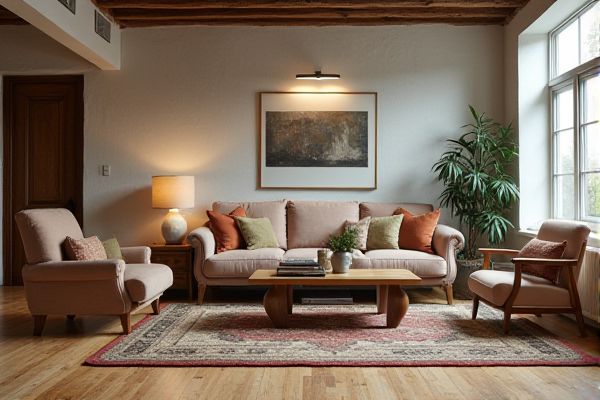
Upcycled furniture offers a unique charm and sustainability by repurposing old items, making it an eco-friendly alternative to buying new furniture for your basement. Discover how choosing upcycled pieces can enhance your space while reducing waste by reading the rest of the article.
Table of Comparison
| Feature | Upcycled Furniture | New Furniture (Basement) |
|---|---|---|
| Environmental Impact | Reduces waste, repurposes materials | Higher resource consumption, manufacturing waste |
| Cost | Generally lower, budget-friendly | Varies; often more expensive due to new materials |
| Uniqueness | One-of-a-kind, custom designs | Mass-produced, uniform styles |
| Durability | Depends on material quality and restoration | Typically durable with warranties |
| Availability | Limited and variable | Widely available in basement clearance sales |
| Style Options | Eclectic, vintage, creative | Modern, standard designs |
| Maintenance | May require upkeep and refinishing | Low maintenance; new materials |
Introduction to Basement Furniture Choices
Basement furniture choices often involve a decision between upcycled furniture and new furniture, each offering distinct benefits. Upcycled furniture provides eco-friendly, unique pieces crafted from repurposed materials that add character to basement spaces. New furniture offers modern designs and durability, with options tailored to basement environments such as moisture-resistant materials and space-saving features.
What Is Upcycled Furniture?
Upcycled furniture refers to pieces that have been creatively transformed from existing items or discarded materials into new, functional furniture, often enhancing sustainability by reducing waste. Unlike new furniture made from raw resources, upcycled pieces preserve character and uniqueness while contributing to eco-friendly living spaces. This approach is especially beneficial for basements, where custom, budget-friendly, and durable furniture can be designed using reclaimed wood, metal, or other materials.
Understanding New Furniture for Basements
New furniture for basements often features moisture-resistant materials like treated wood, metal frames, or synthetic fabrics designed to withstand humidity and temperature fluctuations. Opting for modular designs and compact storage solutions maximizes limited basement space while maintaining functionality and style. Investing in durable, easy-to-clean finishes ensures longevity and preserves appearance in basement environments prone to dampness and dust.
Cost Comparison: Upcycled vs New Furniture
Upcycled furniture offers a significantly lower cost compared to new furniture for basement spaces, often reducing expenses by 50% or more due to reclaimed materials and DIY labor. New furniture involves higher prices driven by manufacturing, shipping, and retail markup, making it less budget-friendly for furnished basements. Choosing upcycled pieces not only saves money but also supports sustainable practices by minimizing waste.
Environmental Impact: Sustainability in Your Basement
Upcycled furniture significantly reduces environmental impact by minimizing wood waste and lowering carbon emissions compared to new furniture production for basements. Choosing sustainably sourced or reclaimed materials conserves natural resources and prevents landfill overflow. Incorporating upcycled pieces enhances basement sustainability by promoting eco-friendly living and reducing the overall carbon footprint.
Style and Customization Options
Upcycled furniture offers unique, one-of-a-kind styles with customizable elements that showcase creativity and environmental consciousness in basement design. New furniture typically provides a broader range of standardized styles and modular options, catering to specific spatial and aesthetic preferences for basements. Choosing upcycled pieces enhances character and sustainability, while new furniture delivers consistency and tailored functionality.
Durability and Quality Considerations
Upcycled furniture in your basement often offers unique durability due to solid wood and craftsmanship, while new furniture typically provides consistent quality with modern materials and manufacturing standards. Carefully evaluate construction methods, material types, and finishing techniques to ensure longevity and structural integrity. Prioritizing these factors helps you choose furniture that withstands basement conditions such as humidity and temperature fluctuations.
Maintenance and Care Differences
Upcycled furniture often requires more frequent maintenance due to its reclaimed materials, which may have existing wear or less durable finishes compared to new furniture. New basement furniture typically features modern coatings and finishes that resist stains and scratches, making care simpler and less time-consuming. Understanding these maintenance differences helps you choose the right option based on your lifestyle and desired effort for upkeep.
Space Optimization in Basements
Upcycled furniture maximizes space optimization in basements by offering customized, multi-functional pieces that adapt to limited areas and irregular layouts. Unlike new furniture, upcycled items can be tailored to fit unique basement dimensions, enhancing storage and usability without overcrowding. This approach promotes efficient use of overlooked spaces, transforming basements into practical, organized living or storage areas.
Which Is Best for Your Basement: Upcycled or New?
Choosing between upcycled furniture and new furniture for your basement depends on factors like budget, style preferences, and sustainability goals. Upcycled furniture offers unique character, reduces environmental impact, and can be customized to fit your basement's dimensions and aesthetic. New furniture provides warranty options, modern designs, and often includes features optimized for basement conditions such as moisture resistance and compact storage.
 homyna.com
homyna.com